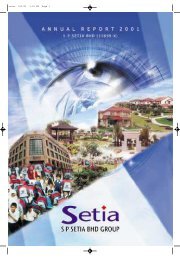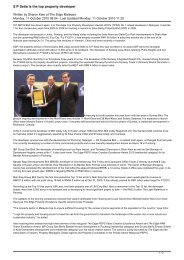Change - S P Setia Berhad
Change - S P Setia Berhad
Change - S P Setia Berhad
Create successful ePaper yourself
Turn your PDF publications into a flip-book with our unique Google optimized e-Paper software.
91<br />
S P <strong>Setia</strong> <strong>Berhad</strong> Group<br />
NOTES TO THE FINANCIAL STATEMENTS<br />
FOR THE YEAR ENDED 31 OCTOBER 2008<br />
1. SIGNIFICANT ACCOUNTING POLICIES (cont’d)<br />
(q)<br />
Receivables<br />
Receivables are initially recognised at their costs when the contractual right to receive cash or another financial asset from another<br />
entity is established. Subsequent to initial recognition, receivables are stated at cost less allowance for doubtful debts.<br />
Known bad debts are written off and allowance is made for any receivables considered to be doubtful of collection.<br />
(r)<br />
Share capital<br />
Ordinary shares are recorded at nominal value and proceeds received in excess of the nominal value of shares issued, if<br />
any, are accounted for as share premium. Both ordinary shares and share premium are classified as equity. Costs incurred<br />
directly attributable to the issuance of the shares are accounted for as a deduction from share premium, if any, otherwise<br />
they are charged to the income statement.<br />
Dividends to shareholders are recognised in equity in the period in which they are declared.<br />
(s)<br />
(t)<br />
Payables<br />
Payables are measured initially and subsequently at cost. Payables are recognised when there is a contractual obligation to<br />
deliver cash or another financial asset to another entity.<br />
Income recognition<br />
(i) Revenue from construction contracts and sale of development properties which are under development is recognised<br />
on the percentage of completion method, where the outcome of the contracts and development projects can be<br />
reliably estimated.<br />
Revenue from construction contracts represents the proportionate contract value on construction contracts attributable<br />
to the percentage of contract work performed during the financial year.<br />
Revenue from the sale of development properties represents the proportionate sales value of development properties<br />
sold attributable to the percentage of development work performed during the financial year.<br />
(ii)<br />
(iii)<br />
(iv)<br />
(v)<br />
(vi)<br />
Revenue from the sale of completed development properties is measured at the fair value of the consideration<br />
receivable and is recognised in the income statement when the significant risks and rewards of ownership have been<br />
transferred to the buyer.<br />
Revenue from the sale of goods is measured at the fair value of the consideration receivable and is recognised in the<br />
income statement when the significant risks and rewards of ownership have been transferred to the buyer.<br />
Dividend income is recognised when the right to receive payment is established.<br />
Interest income is recognised on a time proportion basis.<br />
Rental income is recognised on a straight-line basis over the specific tenure of the respective leases.

















